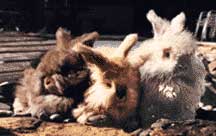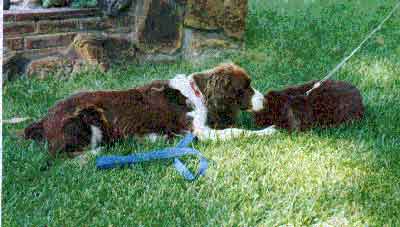
Rabbits are extremely hardy and occasionally delicate. Years may go by without infirmity, and one day that energetic ball of fur becomes a limp puddle of depressed bunnyhood. Oh, no! An interesting species (meant by nature to be low on the food chain) can be a mass of contradictions in the health arena.
As an adaptation of nature, rabbits have a high pain threshold. Nature protects them from feeling much pain, especially when they are about to become a meal. Another common occurrence is for rabbits to suffer heart attacks upon confrontation, and they pass out to avoid the unpleasantness of being eaten.
Of course, pet rabbits do not have to face the realities of nature's savagery. Nevertheless, they are genetically wired to not show pain (so the predator will not see their weakness). This causes a problem for both the pet rabbit and their human caretakers -- when problems strike, illness or pain can be hidden until all the bunny's internal resources are exhausted, and they quietly collapse.
Rabbits rarely get sick, but when they do, you only have 12 to 24 hours to start treatment and two to three days to get on track with the corrections. Don't delay! When a rabbit is sick, it will be overly quiet, depressed, and you will notice a reduction in eating and drinking. Their eyes may be glazed, their respiration increased or, as the illness progresses, they may become limp. They may also grind their teeth in pain.
A healthy bunny will be active, curious and bouncy, especially when allowed to play in the house or yard while being observed. Rabbits actually have very hardy systems, and in some ways, recuperate rapidly, such as after being cut.
A veterinarian should be called immediately if your first aid efforts do not get fast results. Rabbits are considered exotic animals, and many vets refuse to treat them. Do research ahead of time. To find a vet that treats rabbits, ask them about their experience or for a recommendation.
An attentive family of a house rabbit will notice unusual behavior sooner than owners of a caged rabbit. House rabbits tend to live longer than their caged brethren because of this attention (along with other advantages such as love, a varied healthy diet and more vet care). Owners of caged rabbits (unless they play with it regularly) may not notice a change in behavior in the 30 seconds it takes to throw in some food and check the water.
The most important rule for the care and first aid of a rabbit is to pay attention to your bunny! When you are familiar with all your rabbit's mood and quirks, you are more likely to notice if they are "off." Because of their non-revealing nature, the signs start subtly, then either self heal or multiply into a full-fledged disaster. Fortunately, disasters rarely happen, but if they do, these are some signs to look for and the measures to deal with the possible problems.
Is your bunny eating? First, check the water supply. Because their food is dry, rabbits cannot eat without a large, clean water source. Is the water bottle broken? Does your rabbit frequently tip over the water bowl? Get a big crock. Are the kids forgetting to give the bunny water? Remember, a bunny can only survive a day or so without water, and if their water supply is irregular or dirty, they become thin and unhealthy.
Does your bunny have droppings in the litter pan? A sure sign that the rabbit is not drinking or eating, has an internal blockage or a "sour stomach" is a lack of droppings in the pan. If the tray is dirty, change it so you can get a fresh look at their droppings. If you keep your rabbits outdoors, put newspaper under their cage.
If food or the water source is the problem, fix it by getting clever. Test the bottle to see if it works. Use a different feeder (especially if the bunny throws its food out) -- give them a crock instead of a bottle or a huge crock that they can't throw the food out of. Put a rock in the bottom of the crock so they cannot dig but can eat. Young and small bunnies may need a lower food/water source that they can reach. Be resourceful.
This problem can have different causes. Have your rabbits been chewing on rags or plastic items like a cat box?
First Aid:
If so, remove the item and give your rabbit a cat hairball remedy by mouth or syringe with the needle removed. This lubricant will help the blockage through your rabbit's system. Rabbits cannot throw up, so it is important to use toys and equipment around them that are safe for them to chew. Some blockages must be handled by a vet, it's understandably expensive, so it is more prudent to prevent the problem.

Sometimes long-haired breeds and molting rabbits of any breed can get fur or wool stuck in their stomach. The best way to prevent hairballs or impactions is to feed loose hay regularly. Feeding hay only (removing all other food) one day a week is very effective in preventing hairball formation. As I said before, rabbits cannot expel hairballs by vomiting so we need to use roughage to drive fur through the system.
First Aid:
If you suspect a fur blockage, remove all regular pellets and offer hay only, especially if you see their droppings strung together by strands of hair. If they do not eat the hay, buy a fresh pineapple, cut some up and put it in the blender, and see if they will drink it. If not, force feed 1/4 cup (for a medium-sized rabbit) of strained pineapple juice to the bunny twice a day using a feeding syringe until they willingly eat a considerable amount of hay a day. If they do not start eating within a day, visit your vet. You can purchase a feeding syringe from your dentist, it is used to irrigate teeth.
Rabbits' stomachs are very sensitive. It seems to be their weak point. A large ingestion of fruits or vegetables, a new brand of food or a day grazing on grass can cause severe diarrhea or even death. To prevent this, blend new brands of food with the old feed for a few days. Slowly introduce fruits and vegetables.
Avoid foods that are dangerous or of no nutritional value. For example, head lettuce is nutritionally useless and can cause diarrhea; cabbage creates gas; and celery strings can tie up the intestines. Other foods and grass grazing should be introduced slowly. Poisonous plants are eaten with enthusiasm by rabbits, so you need to identify and eliminate them from your house and yard.
First Aid:
Remove all fruits and vegetables. Put a large serving of Quaker Oats on top of your rabbit's pellets and offer hay, this will firm up their droppings. If diarrhea continues, antibiotics like Terrimycin powder can be mixed in their water. A product called Dri Tail for hamsters works pretty well, it is not OK'd for rabbits so I only use it in an emergency once or twice 'till I can get an antibiotic like Terrimycin powder from the pet or feed store. I do not put the balance of the Dri-Tail bottle in their water, I only use the eyedropper once when the problem is discovered and again12 hours later then go buy Terrimycin.. I've also had good luck with Benebac, a highly concentrated yogurt paste to help replace the good flora and fauna in my rabbits' intestinal tract. I've also used vanilla yogurt that has natural cultures, although opinions vary about milk products for rabbits. I recommend keeping a mild antibiotic, such as Dri Tail or Terrimycin powder on hand. It is important to give it to the rabbit as soon as you notice a problem. If diarrhea doesn't clear up within a few hours, see a vet immediately. Note: rabbits are allergic to Pennicillin products - do NOT use them.

Trim toe nails regularly so they don't get caught on the carpet and on your clothing. Never hold a rabbit exclusively by the ears. The cartilage in the ear can break or bend and is not repairable. Don't catch your rabbit by the tail! Always hold your rabbit's whole body as carefully as you would hold a baby.
First Aid:
If your rabbit sustains an injury to its toes, ears or tail, keep it contained for a few days so nature can heal the best it can. Broken ears do not heal. Toes and tails can be bound to the body to knit, but it is difficult -- consult your vet. If you noticed it too late to fix; the injury is only cosmetic, your bunny is still your cute pet, and it doesn't matter to them.
Don't startle your rabbit because it may move quickly and break its leg. Don't let your dog chase your rabbits because your bunny may get hurt trying to get away. Always chaperon dogs and bunnies. A dog must have an excellent response to "down" and "stay" commands before you let it be a pal to your rabbit. I suggest keeping your bunny on a cat harness and leash (also the dog) during the first few months of getting to know the yard, house or other pets.

First Aid:
Keep your bunny quiet if you suspect its leg is broken. A vet will need to set it. Bring your rabbit to the vet wrapped in a towel. Setting a leg is very expensive. I "bunny sat" a male English Angora that broke his leg jumping off a table. The owners were first-time rabbit owners who had just adopted the Angora, and they thought the rabbit was just sore. It turned out the leg was broken, but it was too late to set. The rabbit is beautiful and enjoys the love of the whole family.
They dropped him off for bunny sitting late at night and left the country. Imagine my agony the next day when I saw the broken leg. I couldn't afford to set it (way over the $100 I had been authorized for vet fees), and there was no phone number where I could reach the family. For two weeks I worried and agonized over my decision not to fix it. When they got back, they told me it had been broken since he was 10 weeks old. They were so used to his infirmity that they forgot to tell me! The moral of this story is to see a vet right away if you suspect your rabbit has broken a limb. (And don't forget to tell your bunny sitter about any disabilities you have become blind to -- please!).
In nature, rabbits are burrowers, and they go underground to avoid heat. They are happiest in cool temperatures. In an outdoor cage, a rabbit is highly susceptible to heat stroke. It is by far the largest killer of bunnies in our area. Rabbits are covered with fur and do not pant to cool off like a dog would. If left uncooled in a cage, car or out in the sun, their brain can swell, resulting in a painful death.
The best way to avoid heat stroke is to have an indoor cage where you can keep your rabbit when hot weather reaches over 85 degrees F. This is extremely important if you work during the day! If your rabbit must stay outdoors, a frozen two-liter soda bottle can be placed in the cage to keep your pet cool. I highly recommend keeping two additional frozen bottles in the freezer so that one is always available.
If temperatures reach over 90 degrees, a fan is essential to keep air circulating. Point the fan at half the cage so your rabbit can move in or out of the breeze. Wet burlap sacks can be suspended from the cage sides, along with the fan for a swamp-cooler effect. Better yet, get a misting system -- they are available at hardware stores during the summer. Attached to a hose and timer, misters cool the surrounding temperatures by as much as 15 degrees.
First Aid:
A warm bunny will lie flat on the floor of its cage, and have higher respiration. A very hot bunny will develop a wet area around their nose and could be limp. Cool warm rabbits by wetting their fur with a spray bottle and getting them out of the heat. Immediately cool hot bunnies by soaking their fur in a bathtub or sink full of lukewarm water. Put them in front of a fan to lower their temperature quickly and to stop the swelling of the brain. They will show signs of recovery by brightening up and becoming active again. Let them dry naturally and watch for signs of depression. Give them lots of attention after they are cool.
If you have experienced the opposite of heat stroke -- a wet bunny in cold weather -- here's what you should do. Dry the rabbit and warm it up gently. Use a low, slow, warm setting on your hair dryer. Introduce the hair dryer slowly, so you don't frighten the rabbit. Keep your hand inside the stream of warm air so that you will not burn the rabbit's skin.
To prevent any back injuries, never startle your bunny as you round the corner to their cage. A startled rabbit can break their back as they bounce around frightened inside their cage. Always announce your arrivals. Also, keep an eye on your bunny when they are loose.
Our new French Lop yard rabbit fell in our pool within 10 minutes of her first unleashed foray in the yard. I rescued her within seconds, but she pinched her back in the fall. How did I know it wasn't broken? She had use of and feeling in her hind legs, but it was difficult for her to move. I found a chiropractor who worked with a vet. Only two sessions improved her mobility. She's a little crooked, but she can run as fast as ever, and she just had her first litter.
On the other hand, we adopted a rabbit that was raised in the country. He broke his back running circles around his cage when he was frightened by an ice cream truck the first day he was at our rabbitry. He had no feeling in his legs and couldn't move them. Sorrowfully, we had to put him to sleep.
Bunny cuts heal amazingly fast. Clean the cut if it is dirty and apply Neosporin or a similar ointment.
Use cat flea powder only. Never flea dip a rabbit. They are very susceptible to poison. A flea dipped rabbit can die within minutes.
Flys lay eggs in the soiled area under a rabbits tail if he has diarrhea. Within hours the eggs hatch and start to eat the rabbit alive. Gross! Within one day the skin can part and a huge hole is created in the rabbit. And it hurts! MAKE AN APPOINTMENT with your vet ASAP, but before you go, print this out and bring it with you. If you cannot get an appointment right away, then follow this: EMERGENCY care if you cannot get to the vet: Pick off the maggots and wash the area under water. Go to your local feed store and buy ivermectin paste, a horse wormer. Give the rabbit a q-tip sized bit of ivermectin in the mouth. Rub ivermectin in the wound. Dry the rabbit and keep him in the house. By the next day the maggots will have died and dropped dead into the bottom of the cage. If you caught it in time, the wound won't be too big. Do not wait an extra day to deal with this! The hole will double and triple in size in the matter of hours. If it's small just put Neosporin on it and keep them in the house (for weeks) until the wound closes. The vet may choose to stitch it. If the wound is large you'll need to wash his skin and fur out with a wound wash available from your vet or local pharmacists. Keep the skin moist with a product that your pharmacist will recommend until the wound closes. I have used duct tape as an emergency butterfly bandage when needed.
Mitox or whatever your vet prescribes, works well. Keep it on hand. Completely disinfect the cage using diluted bleach (do not use Pinesol or other strong cleaners -- they are poisonous to rabbits) and rinse thoroughly. Do it again one week later, use cat flea powder for two weeks and wash all bedding when disinfecting the cage. Ear mites or fur mites also may be responsible for excessive loss of fur.
Terramycin eye ointment is available at feed stores. Wash the eye with warm water, and carefully trim wet fur around the eye. Follow directions on Terramycin ointment.
Oops! Your bunny jumped and missed. Check those teeth! Top teeth should overlap the bottom. If one is missing or broken, check every day to be sure they are growing back in correctly. Gentle pressure, after a week or so, can be applied three times a day to guide the tooth to the correct alignment. Incorrectly aligned teeth can grow into the nose or into the mouth and prevent eating. Misaligned teeth need to be trimmed frequently. Your vet or groomer can teach you how to trim them. Here is a video I made about trimming teeth: Trimming a Rabbits Teeth- Malocclusion Video: 1 min, 48 sec.
I am not a veterinarian. These suggestions are from my experience with rabbits, as well as from personal research and stories I have heard. I highly suggest you get several good books from the library and learn as much as you can about rabbits -- they are unique creatures. Rabbits are a relatively new pet, so not much is known about their care. Through publications like Rabbits Annual, I try to pass along helpful information about caring for your rabbit, but my word is not gospel. Many people and organizations are attempting to fill the gaps so that our pets get the best of care. However, the responsibility for the care of your pet rests with you.
The best first aid is prevention. Be familiar with your rabbit, note their moods and habits so you can tell when something is not right. Keep first aid products on hand, and treat problems immediately, don't delay. If possible, raise rabbits indoors and make them part of your family, you'll enjoy every minute of it.


***If you linked to this page via the Bunny Central Home Page, simply close this window.***
Link to Bunny Central Home Page (for those who have not been there yet)